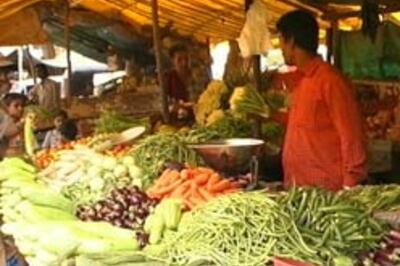
views
In September 2017, when BJP president Amit Shah visited a Dalit party member’s house, the West Bengal state unit argued that “class not caste” is what holds the key for the state. But as the BJP prepares to make inroads in the state, the politics of identity, ethnicity and caste might well hold the key.
Bengal, with its 42 Lok Sabha seats, has the third-largest share in Parliament after Uttar Pradesh (80) and Maharashtra (48). But unlike in the two states, the BJP’s presence in Bengal is scant, limited to two seats (Darjeeling and Asansol) while the state has typically voted in favour of the party ruling the state.
The BJP’s target in West Bengal, which will vote in seven phases, sources said, is 20 seats. The party hopes this number will make up for any potential losses elsewhere. An analysis of these 20 seats reveals a clear picture of the tactics adopted by the BJP and its Bengal in-charge Mukul Roy.
Consider this: Of these 20, six are reserved for SC or ST communities while caste and tribal identities will be key in at least six other. Moreover, nine seats are along the border where the BJP’s emphasis on the issues of border infiltration and post-partition rights might yield dividend. Finally, the BJP is also looking to try and exploit the vacuum left behind by a weakening CPI(M) by focusing on former strongholds of Left Front’s smaller constituents.
The BJP will also have an advantage, admitted leaders, with the division of polls into seven phases, allowing them to concentrate their cadre to a few key seats in each phase.
In the first phase, the BJP is eyeing Cooch Behar (SC) and Alipurduar (ST). In the second phase, it will target Jalpaiguri (SC) and Raiganj. In the third phase, it will focus its energy on Maldah North and Balurghat. In the fourth, its targets include Krishnanagar and Bolpur (SC). In the fifth phase, it’ll target Sreerampur, Barrackpore, Bongaon (SC) and Howrah, while in the sixth, it’ll target the tribal-dominated seats of Purulia, Bankura, Jhargram (ST) and Mednipur. Finally, in the last phase it’ll look to focus on the two seats in Kolkata and adjoining Dum Dum and Barasat seats.
Asked about the party’s strategy so far, Roy told News18, “We have gone all out to improve our organisation. We are completing many projects in the state that were long-term demands.”
Caste and Tribal Identity
In 2011, when Mamata Banerjee picked the youngest son of the Matua community’s spiritual leader ‘Boroma’ Binapani Devi as a candidate for Assembly polls, she had virtually cemented the votes of nearly 1.5 crore voters in the state, spread over five Lok Sabha constituencies.
At the time, Banerjee’s utilisation of caste identity in electoral politics raised eyebrows and now, after the death of the 100-year-old spiritual leader, this might be her biggest challenge. A bitter family feud has erupted and it was no accident that Prime Minister Narendra Modi launched his Lok Sabha campaign from Thakurnagar in Bangaon. Two factions have since emerged, one siding with the BJP and the other with TMC.
The Matuas trace their ancestry to East Bengal after partition and also after the formation of Bangladesh. The Prime Minister has repeatedly flagged the Citizenship (Amendment) Bill, while after Binapani Devi’s death, the Mamata Banerjee cabinet hurriedly formed a panel to look into issues of rehabilitating refugees from east Bengal. Matuas are Namasudras, a Scheduled Caste group concentrated in six seats - Krishnanagar, Ranaghat, Barrackpore, Barasat, Bongaon and Coochbehar.
BJP leaders added that they’ve also slowly been making inroads into the unions comprising workers of tea estates that dot north Bengal, but are politically important in Jalpaiguri, Alipurduar and Cooch Behar. “These workers are mostly tribal people or Dalits. Their rights have systematically been ignored, first by the Left and then the BJP. That is something we have been working on,” said a senior BJP leader.
Caste and tribal identity is a thorough line that runs through each of the seats that the BJP is targeting. In Balurghat, for instance, there are two SC reserved Assembly segments and another reserved for STs.
A senior leader explained, “There are two factors here. The Left and the TMC, after a fashion, have long since underplayed the importance of caste in day-to-day interactions. But that doesn’t mean that caste is not a factor when it comes to how lives are shaped. For instance, Bengal has had a Brahmin CM for 19 years.”
The leader added, “Caste also helps negate the Muslim votes that Mamata Banerjee will get. We are trying to replicate the 2014 model used in UP and asking voters to embrace their religious identity of being Hindu.”
The presence of RSS in south Bengal – active in the area for decades – will also be key in the tribal dominated seats of Purulia, Bankura and Jhargram, said a BJP leader. “The RSS operates schools here where no one else will. We have been working in the area since before Mamata Banerjee was CM. A number of first-time voters in the area have studied in RSS schools and are active workers,” said a senior BJP leader.
Border and Partition
It was in the late 80s that the BJP first attempted to make inroads in Bengal – the state of their founder SP Mookherjee. But ever since then, the issue of infiltration from Bangladesh into India has been key for the party. Raised by both Modi and home minister Rajnath Singh in the 2016 Assembly polls, the BJP has since added another layer to it in the form of citizenship rights for refugees.
As early as 2014, Modi had asked Mamata Banerjee in an election rally at Krishnanagar as to why “Matuas aren’t treated as Indians”, and although the Citizenship Amendment Bill created a row in the Northeast, party leaders think it was well worth the risk.
A state committee leader and likely candidate from south Bengal said, “The border was key. It defines Bengal, but infiltration was just part of the puzzle. It is a polarising issue and will be key in seats like Malda North. But the issue of refugee rights strikes an emotional chord across the state.”
Strongholds of Smaller Left Parties
Cooch Behar saw All India Forward Bloc win consecutive elections from 1962 till 2009. At Alipurduar, the RSP dominated from 1977 to 2014 while it won 10 elections at Balurghat. In Purulia, the CPI won consecutive elections from 1980 to 2014.
But with the weakening of the Left Front, the BJP has sensed an opportunity. “These were never seats that voted for the party in power in Kolkata. There was a sense of dissonance that the people here felt, from the ruling party. This is what allowed many of these smaller parties to cement their reign,” said a BJP source.
“But now with the weakening of the Left’s cadre – something that the TMC actively facilitated – there is a vacuum that we feel we can fill,” said a senior leader.




















Comments
0 comment